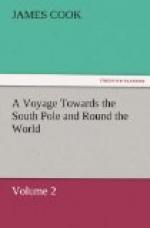Who would have thought that an island of no greater extent than this, situated between the latitude of 54 deg. and 55 deg., should, in the very height of summer, be in a manner wholly covered, many fathoms deep, with frozen snow, but more especially the S.W. coast? The very sides and craggy summits of the lofty mountains were cased with snow and ice; but the quantity which lay in the valleys is incredible; and at the bottom of the bays the coast was terminated by a wall of ice of considerable height. It can hardly be doubted that a great deal of ice is formed here in the water, which in the spring is broken off, and dispersed over the sea; but this island cannot produce the ten-thousandth part of what we saw; so that either there must be more land, or the ice is formed without it. These reflections led me to think that the land we had seen the preceding day might belong to an extensive track, and I still had hopes of discovering a continent. I must confess the disappointment I now met with did not affect me much; for, to judge of the bulk by the sample, it would not be worth the discovery.
I called this island the isle of Georgia, in honour of his majesty. It is situated, between the latitudes of 53 deg. 57’ and 54 deg. 57’ S.; and between 38 deg. 13’ and 35 deg. 34’ west longitude. It extends S.E. by E. and N.W. by W., and is thirty-one leagues long in that direction; and its greatest breadth is about ten leagues. It seems to abound with bays and harbours, the N.E. coast especially; but the vast quantity of ice must render them inaccessible the greatest part of the year; or, at least, it must be dangerous lying in them, on account of the breaking up of the ice cliffs.
It is remarkable that we did not see a river, or stream of fresh water, on the whole coast. I think it highly probable that there are no perennial springs in the country; and that the interior parts, as being much elevated, never enjoy heat enough to melt the snow in such quantities as to produce a river, or stream, of water. The coast alone receives warmth sufficient to melt the snow, and this only on the N.E. side; for the other, besides being exposed to the cold south winds, is, in a great degree, deprived of the sun’s rays, by the uncommon height of the mountains.
It was from a persuasion that the sea-coast of a land situated in the latitude of 54 deg., could not, in the very height of summer, be wholly covered with snow, that I supposed Bouvet’s discovery to be large islands of ice. But after I had seen this land, I no longer hesitated about the existence of Cape Circumcision; nor did I doubt that I should find more land than I should have time to explore. With these ideas I quitted this coast, and directed my course to the E.S.E. for the land we had seen the preceding day.




